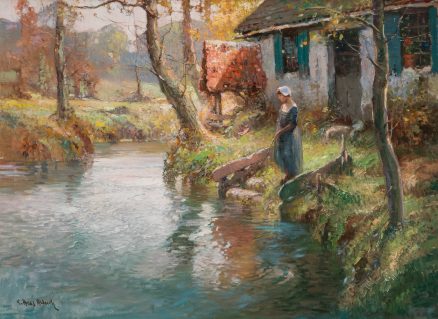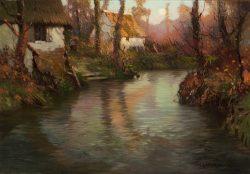Untitled Landscape with Figure
, circa 1920sOil on canvas, 281/2 by 383/8 inches
- Categories
- Landscapes
- Zoom in on Artwork
- Print Page
- Email Page to Friend
Like Normandie Sunset, also in the Schwartz Collection, this painting follows George Ames Aldrich’s perennially successful landscape formula, featuring a rustic cottage on the bank of a stream, its rippled surface suggesting rapid flow. The composition’s high horizon, the gently rounded stream banks, and the soft, complementary hues create a sense of shelter, comfort, and calm, offering an idealized fantasy of timeless rural life. While the foreground is relatively shadowed, the distant meadow and trees glow with warm midday light. Aldrich often enlivened such scenes with a female figure: here, she stands on crude steps by the riverbank. She holds a stick-like object, perhaps a makeshift fishing-rod, angled down toward the water, and seems to fix her attention on its surface, where circular ripples hint at the prospect of a catch. With her old-fashioned costume—a simple blue dress and domestic white cap—the young woman is an accessory of the pastoral setting rather than its focus.
Aldrich’s almost obsessive reiteration of the formula seen in this work reflects his targeted consumers, the newly affluent middle-class managerial workers, entrepreneurs, and industrialists (and their spouses) in prospering regional cities, from South Bend, Indiana, to Sioux Falls, South Dakota. Impressed by the artist’s abundantly flaunted (if unsubstantiated) East Coast and European credentials, they aspired to the status of knowing collectors, seeking safety in conventional artistic values. Works such as this canvas satisfied their ideal of the framed original oil painting as representational yet manifestly “artistic,” its subject matter offering a release from quotidian reality and its color scheme soothing and harmonious. Complementing the consciously tasteful décor of well-appointed period-revival houses then spreading across the American suburban landscape, Aldrich’s “livable pictures” would “enrich and enoble the home environment,” according to a contemporary admirer.i
Few of Aldrich’s many landscape paintings bear a date, and their lack of variation makes them difficult to assign to a particular period of his career. Like Normandie Sunset, this work was most likely made in the 1920s—the decade of Aldrich’s most prolific activity and greatest success—as suggested by the rather mannered treatment of the distant massed trees and broad, loose brushwork; by the early Thirties, Aldrich’s landscape paintings would manifest a somewhat more muscular and simplified treatment of natural features.
Wendy Greenhouse, PhD
Donated by M. Christine Schwartz to the South Bend Art Museum in South Bend, Indiana, in 2021
i Lincoln J. Carter Jr., “Fine Paintings by G. Ames Aldrich in Middle West Homes,” and “Woman’s Club Hears Art Critic from Illinois,” undated clippings in Aldrich scrapbook of clippings and ephemera, 36/A22 and 40/A37, collection of Peter Lundberg, quoted in Wendy Greenhouse et al, The Art of George Ames Aldrich (Bloomington, IN: Indiana University Press, 2013), 23.

